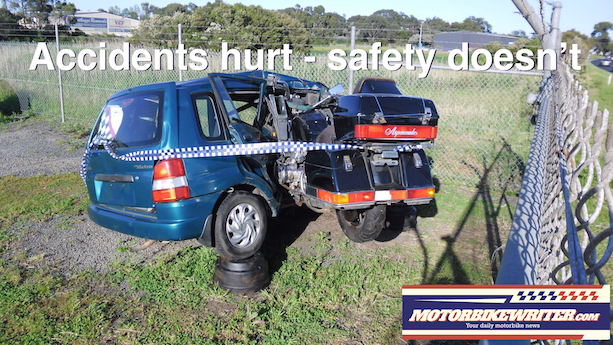Riders might think drivers don’t care about hitting us, but there is actually scientific evidence that shows they really don’t see us.
Of course no driver wants to run into a motorcycle, bicycle or pedestrian. After all, it would cause extensive and expensive damage to their vehicle!
The problem is that comparatively small road users tend to exist in drivers’ blind spots and they need to be made aware of this so that they look twice.
There have been several scientific studies done into “Sorry Mate, I didn’t See You” (SMIDSY) crashes between cars.
The Alliance of British Drivers has produced the following excellent video which explains one of the scientific principles of SMIDSY called saccadic masking.
Do a Google search for the term and you will find it is a “phenomenon in visual perception where the brain selectively blocks visual processing during eye movements in such a way that neither the motion of the eye (and subsequent motion blur of the image) nor the gap in visual perception is noticeable to the viewer”.
In other words, when a driver looks left and right at an intersection, there are blind spots in their vision that hide small objects such as pedestrians, cyclists and motorcycle and scooter riders.
To test it, go to the bathroom mirror and get fairly close. Now, look from one eye to another. You will not be able to see your eye move.
Yet someone else will see your eyes moving from side to side.
Perception problems
Researcher Pat DeLucia reached her scientific finding by testing people in computer simulations.
She studied participants who viewed two approaching objects simultaneously – one large and one small. The viewer had to nominate which would reach them first.
Her study, “Current Directions in Psychological Science”, indicates that an object’s size affects distance perception, causing drivers to miscalculate riders’ distance and speed.
“People generally picked that simpler heuristic: Larger is closer,” says DeLucia.
Motorcycles, pedestrians and cyclists are the smallest road users. Of those, motorcycles are the fastest accelerating, so we have double the perception problem.
Drivers think we are going to arrive much later than we actually do and think they have plenty of time to make a turn in front of us.
Stop SMIDSY
The video above is targeted at drivers, not riders. And that is exactly what needs to happen to stop SMIDSY.
Our taxpayer dollars should be spent on educating drivers that SMIDSY, saccadic masking and perception problems really do exist and to always look twice.
The video not only suggests drivers look twice, but also train themselves to see better and avoid saccadic masking.
10 ways riders to avoid SMIDSY crashes
- Position on the road is important. You need to ride in the wheel track closer to the centre line so you are visible sooner to oncoming traffic or vehicles turning across your path. It also gives you a buffer from vehicles suddenly emerging from a parking bay.
- Weaving from one wheel track to the other also draws attention. It may look erratic and as though you have lost control, but it attracts much-needed driver attention.
- Never assume a driver has seen you.
- Assume they haven’t seen you and prepare an exit route in case they drive out in front of you or merge into your lane.
- Don’t ride in a vehicle’s blind spot.
- Give yourself a buffer zone from other vehicles.
- Slow down and get ready to take evasive action if you see a vehicle at an intersection.
- Wait until you see the whites of their eyes before accelerating. And even then, prepare for them to make a sudden move.
- If so, it is best to think about changing course behind the car, rather than in front of it. The normal reaction is to weave away from the direction that the threat is coming. However, that leads you into the direction the threat is heading, so you may still collide.
- If you don’t see the whites of their eyes, then it might be time to give a polite toot on the horn to alert them.




